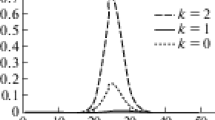Abstract
Atmosphere and ocean systems can be simulated effectively by discrete numerical models and, provided that the initial states of the system are known, accurate forecasts of future dynamical behaviour can be determined. Complete information defining all of the states of the system at a specified time are, however, rarely available. Moreover, both the models and the measured data contain inaccuracies and random noise. In this case, observations of the system measured over an interval of time can be used in combination with the model equations to derive estimates of the expected values of the states. The problem of constructing a ‘state-estimator,’ or ‘observer,’ for these systems can be treated by using feedback design techniques from control theory. For the very large nonlinear systems arising in climate, weather and ocean prediction, however, traditional control techniques are not practicable and ‘data assimilation’ schemes are used instead to generate accurate state-estimates (see, for example, Daley, 1994; Bennett, 1992).
Access this chapter
Tax calculation will be finalised at checkout
Purchases are for personal use only
Preview
Unable to display preview. Download preview PDF.
Similar content being viewed by others
References
Barnett, S. and Cameron, R.G. (1985) Introduction to the Mathematical Theory of Control, 2nd edition, Clarendon Press, Oxford, UK.
Bennett, A.F. (1992) Inverse Methods in Physical Oceanography, Cambridge University Press, Cambridge, UK.
Bergthorsson, P. and Doos, B.R. (1955) Numerical weather map analysis, Tellus, 7, 329–340.
Bierman, G.L. (1977) Factorization Methods for Discrete Sequential Estimation, Mathematics in Science and Engineering, V. 128, Academic Press, New York.
Bratseth, A.M. (1986) Statistical interpolation by means of successive corrections, Tellus, 38A, 439–447.
Cohn, S. E., da Silva, A., Guo, J., Sienkiewicz, M. and Lamich, D. (1998) Assessing the effects of data selection with the DAO physical-space statistical analysis system, Monthly Weather Review, 126, 2913–2926.
Courtier, P. (1997) Dual formulation of four-dimensional variational assimilation, Quart. J. Roy. Met. Soc., 123, 2449–2461.
Courtier, P., Thepaut, J-N. and Hollingsworth, A. (1994) A strategy for operational implementation of 4D-Var, using an incremental approach, Quart. J. Roy. Met. Soc., 120, 1367–1387.
Cressman, G. (1959) An optimal objective analysis system, Monthly Weather Review, 87, 367–374.
Daley, R. (1994) Atmospheric Data Analysis, Cambridge University Press, Cambridge, UK.
Ghil, M. and Malanotte-Rizzoli, P. (1991) Data assimilation in meteorology and oceanography, Adv. Geophys., 33, 141–266.
Griewank, A. and Corliss, G.F. (1991) Automatic Differentiation of Algorithms, SIAM, Philadelphia.
Griffith, A.K. (1997) Data Assimilation for Numerical Weather Prediction Using Control Theory, The University of Reading, Department of Mathematics, PhD Thesis.
Kaiman, R.E. (1961) A new approach to linear filtering and prediction problems, Transactions of the ASME, Semes D, 83, 35–44.
Lawless, A.S. (2001) Development of Linear Models for Data Assimilation in Numerical Weather Prediction, Department of Mathematics, The University of Reading, Ph.D. Thesis.
Lorenc, A.C. (1986) Analysis methods for numerical weather prediction, Quart. J. Roy. Met. Soc., 112, 1177–1194.
Lorenc, A.C. (1988) Optimal nonlinear objective analysis, Quart. J. Roy. Met. Soc., 114, 205–240.
Lorenc, A.C., Bell, R.S. and Macpherson, B. (1991) The Met. Office analysis correction data assimilation scheme, Quart. J. Roy. Met. Soc., 117, 59–89.
Martin, M.J., Nichols, N.K. and Bell, M.J. (1999) Treatment of Systematic Errors in Sequential Data Assimilation, Meteorological Office, Ocean Applications Division, Tech. Note, No. 21.
Rabier, F., Courtier, P., Pailleux, J., Talalgrand, O. and Vasiljevic, D. (1993) A comparison between four-dimensional variational assimilation and simplified sequential assimilation relying on three-dimensionsal variational analysis, Quart. J. Roy. Met. Soc., 119, 845–880.
Rabier, F., Järvinen, H., Klinker, E., Mahfouf, J.-F. and Simmons, A. (2000) The ECMWF operational implementation of four-dimensional variational assimilation. I: Experimental results with simplified physics, Quart. J. Roy. Met. Soc., 126, 1143–1170.
Sasaki, Y. (1970) Some basic formulisms on numerical variational analysis, Monthly Weather Review, 98, 875–883.
Talagrand, O. (1981) A study on the dynamics of four-dimensional data assimilation, Tellus, 33, 43–60.
Thacker, W.C. (1996) Relationships between statistical and deterministic methods of data assimilation, in Y.K. Sasaki (ed.), Variational Methods in the Geosciences, Elsevier, New York.
Author information
Authors and Affiliations
Editor information
Editors and Affiliations
Rights and permissions
Copyright information
© 2003 Springer Science+Business Media Dordrecht
About this paper
Cite this paper
Nichols, N.K. (2003). Data Assimilation: Aims and Basic Concepts. In: Swinbank, R., Shutyaev, V., Lahoz, W.A. (eds) Data Assimilation for the Earth System. NATO Science Series, vol 26. Springer, Dordrecht. https://doi.org/10.1007/978-94-010-0029-1_2
Download citation
DOI: https://doi.org/10.1007/978-94-010-0029-1_2
Publisher Name: Springer, Dordrecht
Print ISBN: 978-1-4020-1593-9
Online ISBN: 978-94-010-0029-1
eBook Packages: Springer Book Archive




